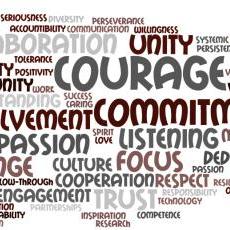






 Credit: Madison Metropolitan School DistrictClosing the achievement gap in Madison schools takes commitment, courage, collaboration and unity, according to community members present at Wednesday night’s Madison Metropolitan School District input session at CUNA Mutual Group.
Credit: Madison Metropolitan School DistrictClosing the achievement gap in Madison schools takes commitment, courage, collaboration and unity, according to community members present at Wednesday night’s Madison Metropolitan School District input session at CUNA Mutual Group.
About 150 attendees jotted down these key words, along with others, on a small notecard in response to a question posed by Deputy Superintendent, Sue Abplanalp.
“Using one word, what do you think it will take to build and sustain a community-wide movement in Madison to close the achievement gaps in the Madison schools?”
The notecards were then collected and compiled into a word cloud, pictured left, shared at the meeting’s close. Popular words were displayed in a bold, prominent font with less popular words surrounding them.
Wednesday’s gathering marked the ninth of 12 sessions held across the city to garner public input and suggestions on the district’s plan to close the racial and socioeconomic achievement gap in student learning over the next five years.
The district’s $105.6 million plan will create and expand programs in six key areas: instruction and support, college and career readiness, culturally relevant practices, safe and positive school environments, family engagement and diverse and qualified workforce.
During the meeting, participants sat at tables grouped around each of the six chapters to discuss positive and negative aspects of the plan and to present ideas or additions for improving each section.
In addition to these participants, about 500 people have attended previous meetings around the city, Superintendent Daniel Nerad said at the meeting.
“I am just very heartened by the kind of turn out that we’re having at these sessions,” he said. “It is very good to see people come out, wanting to come out to have a conversation about what we need to do to better the lives of our kids.”
Nerad provided opening and closing remarks, including an overview of the plan.
As he promised during the first community meeting on February 21, Nerad said MMSD and a research partner have compiled data from the previous sessions and used it to identify common themes in discussions of the plan’s six parts.
At the meeting’s close, Nerad shared popular themes identified from the first four input sessions. The first of these themes relate to one of the crucial questions each discussion group is asked: what are the most promising recommendations included in the plan?
According to the research cited by Nerad, attendees emphasized the importance of the following key programs listed by chapter below.
Instruction and support: one, develop an early warning system to identify struggling students; and two, guarantee all students are reading at their correct grade level.
College and career readiness: expand the Advancement Via Individual Determination (AVID) program to middle schools, a program designed to help prepare students for college and careers. Learn more about this chapter, here.
Culturally relevant practices: implement district-wide diversity training for staff.
Safe and positive school environments: encourage positive behavior support, which focuses on restorative, constructive disciplinary action instead of reactive punishment, like removal from class or suspension from school.
Family engagement: provide parent liaisons in schools to improve communication and understanding between schools, parents and students.
Diverse and qualified workforce: encourage the Grow Our Own program, which will recruit and retain diverse students, staff and teachers from within the district to become future teachers and principals.
The second of the themes Nerad cited addressed the other key question asked during all meetings: what is the plan missing? Attendees regularly discussed the following topics as initiatives missing in the plan.
Instruction and support: clarify intentions and plans to extend the school day, a topic that has supporters on both sides.
College and career readiness: clarify how students will be supported following their graduation from school.
Culturally relevant practices: include parents and family in discussions of how these diverse practices will be implemented.
Safe and positive school environments: include help for students with trauma and emotional issues.
Family engagement: improve communication between schools and parents.
Diverse and qualified workforce: increase transparency in the district’s hiring process.
Participants of Wednesday’s meeting discussed these topics and more. Those seated at the safe and positive school environment table, including attendee Lynett Watkins, discussed mandatory volunteering as something that was missing from the plan.
Watkins, a black mother of four kids, three of whom attend Madison schools, said all students should volunteer as part of school.
Currently, most students required to complete volunteer work during school do so as punishment for getting into trouble. Watkins said this should change.
To learn more about the safe and positive school environment chapter, including Watkins' and other participant’s thoughts, check back later this week for in-depth coverage. For additional information on the achievement gap, read this, or visit the MMSD website.
|
|
|
Welcome to the Madison Commons, a website designed to provide news and information about all of Madison's neighborhoods and a crossroads for the discussion of community issues. The name comes from the idea of a village commons, a place for news, talk, debate, and some entertainment, too, that's open to everyone.
All rights reserved. Read more about the Madison Commons and its partners.

